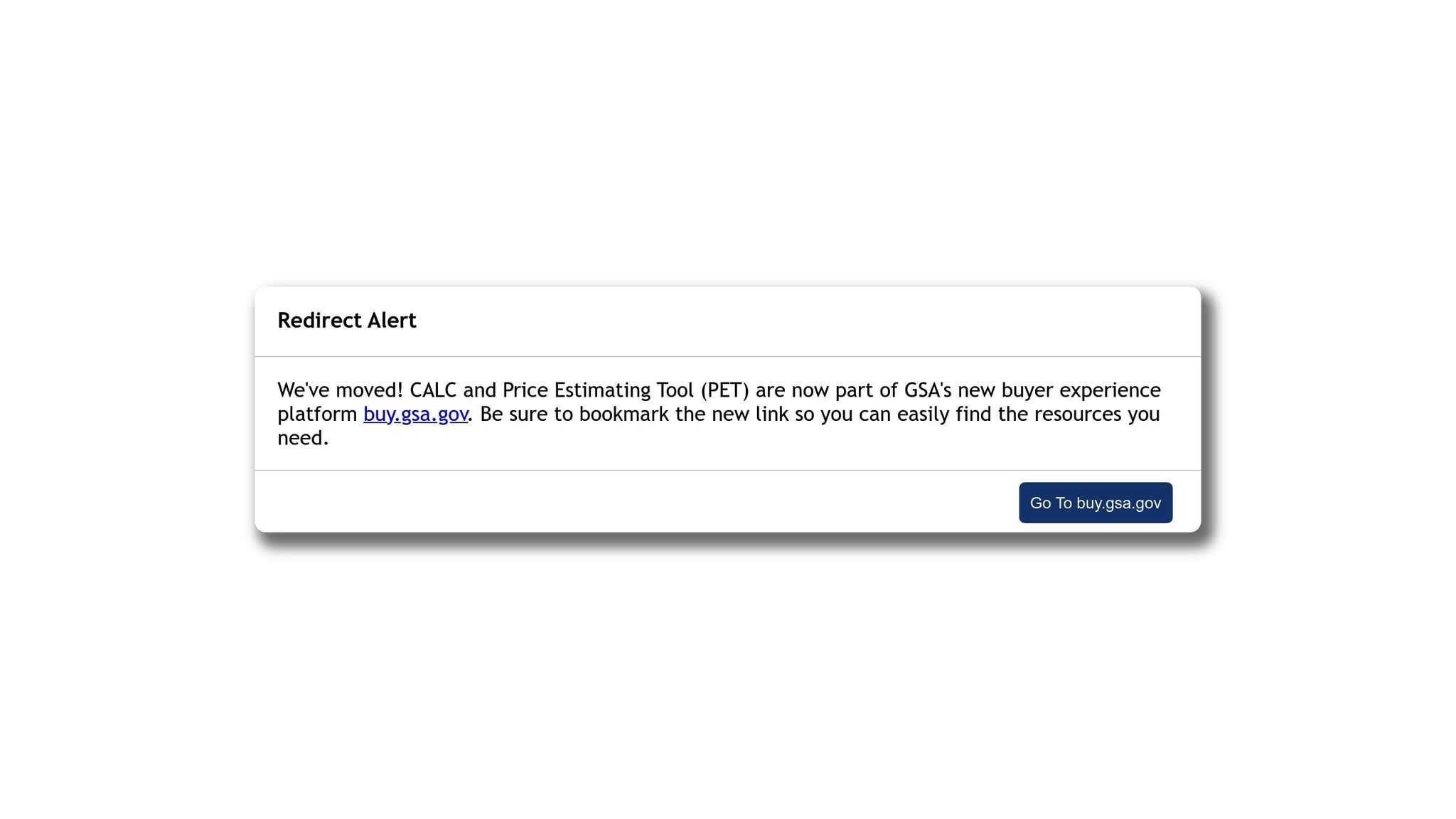The GSA CALC Tool is your go-to resource for analyzing federal labor rates. It provides real-time data on hourly rates from over 10,000 GSA contracts, helping contractors and federal officers make informed pricing decisions. Key features include:
- Insights into Labor Rates: Access Not-To-Exceed Ceiling Rates, average rates, and maximum rates (e.g., $62.74 to $192.60 as of June 16, 2025).
- Advanced Filtering: Refine searches by education, experience, business size, security clearance, and more.
- Competitor Analysis: Compare vendor rates and contract details to assess your position in the market.
- Proposal Support: Use the data to craft competitive pricing strategies and validate cost estimates.
Whether you’re preparing a proposal, analyzing competitors, or negotiating contracts, this tool simplifies and strengthens your pricing strategy. Access it now at buy.gsa.gov.
What Is the GSA CALC Tool?

Tool Definition and Purpose
The GSA CALC Tool is a database designed to showcase awarded labor rates from GSA MAS contracts. It provides access to Not-to-Exceed Ceiling Rates awarded under GSA Multiple Award Schedule (MAS) contracts.
Unlike static pricing guides, the CALC Tool updates in real time, with data uploaded on the day of the award, ensuring users have access to up-to-date market information. This feature offers a clear advantage over other resources like GSA eLibrary or GSA Advantage!.
The tool is invaluable for market research and the development of Independent Government Cost Estimates (IGCEs). For contractors, it’s a game-changer, enabling them to evaluate how their pricing stacks up against competitors on existing MAS contracts.
This rich data resource serves a diverse group of professionals across federal contracting.
Who Should Use This Tool
The GSA CALC Tool is tailored to meet the needs of several key groups in federal contracting:
- Contractors and pricing analysts: These users can quickly analyze competitor pricing without the hassle of manually sorting through awarded contractor lists.
- Proposal teams: By using CALC’s data, proposal teams can craft competitive pricing strategies. The tool provides insight into pricing trends by showing the highest, lowest, and average rates across labor categories.
- Federal contracting officers: This tool is a critical resource during contract negotiations. Since CALC rates represent fully burdened hourly rates awarded at the master contract level for the current fiscal year, they serve as a reliable benchmark for discussions on fair and reasonable pricing.
To support these users, the tool includes several standout features.
Main Features
The GSA CALC Tool boasts features that make labor rate research both efficient and detailed. Its search functionality allows users to perform general searches by labor category or refine results with specific job titles. Advanced filtering options let users narrow down their search further by criteria such as education, experience, business size, security clearance, and Special Item Numbers (SINs).
For those looking to dive deeper into competitor data, the tool enables searches by vendor name or contract number.
Additionally, its statistical analysis tools provide a comprehensive view of pricing trends. Users can see average rates, standard deviations, and worldwide awarded rates, offering a snapshot of the federal contracting market.
Integration with GSA’s buyer experience platform on buy.gsa.gov ensures smooth access to complementary procurement tools and resources. The platform consolidates ceiling prices, fully burdened costs, services data, and worldwide rates into one easy-to-use interface.
How to Use the GSA CALC Tool
Getting Started
You can now find the GSA CALC Tool on buy.gsa.gov, making it conveniently accessible through GSA’s primary procurement platform. To get started, head over to buy.gsa.gov and look for the CALC section.
This tool allows you to search hourly rates for awarded GSA and VA services contracts, providing a snapshot of the current market. Here’s how you can pinpoint labor rates using specific search options.
Finding Labor Rates
Begin by choosing your desired labor category. You can either start with a general search using broad terms like "analyst" or "consultant" or input specific job titles for more focused results. For instance, a general search might display a wide range of roles and rates, while searching for specific titles like "Senior Business Analyst" or "IT Project Manager Level III" narrows the data to meet your needs.
To refine your search, use filters such as:
- Minimum education requirements
- Required years of experience
- Business size (e.g., small or large businesses)
- Security clearance levels (e.g., Secret, Top Secret, TS/SCI)
- Special Item Numbers (SINs)
These filters can be combined to create detailed search parameters tailored to your contract needs. For example, filtering by business size can help you assess your competition, while security clearance filters allow you to benchmark roles with specific clearance requirements. Additionally, you can search by vendor name or contract number, providing insights into competitors’ awarded labor rates across various categories.
Downloading and Using Data
Once you’ve refined your search, you can download the results as an Excel spreadsheet for further analysis. The exported file includes all the applied filters and search parameters. It also provides a comprehensive breakdown of rates, including the highest, lowest, and average prices for the selected labor categories. This format is ideal for creating pivot tables, charts, and custom calculations to aid in developing pricing strategies.
Use the data to compare your proposed rates against awarded prices. This benchmarking helps you evaluate whether your pricing is competitive or needs adjustment to improve your chances of winning contracts.
For proposal development, this data is invaluable. It supports your pricing strategies, validates assumptions, and demonstrates market awareness during evaluations. Teams can use this analysis to justify their labor rate selections and strengthen their proposals.
Additionally, the CALC Tool integrates with GSA eLibrary, offering more detailed contract and vendor information. This added layer of data enhances your competitive analysis, helping you set informed pricing and negotiate effectively.
Use the Secret Power of GSA CALC Tool | Discover the Billing Rates of Your Small Business Competitor
Reading and Using GSA CALC Data
Gaining insights from the GSA CALC tool is essential for accurate market analysis. Let’s break down what the numbers mean, common mistakes to avoid, and actionable pricing strategies.
What the Numbers Mean
When you download CALC data, you’re looking at key metrics that highlight market trends. The average rate is a general indicator of what contractors are charging, but it’s not a pricing benchmark. It reflects a mix of contracts – from small businesses with lean operations to large firms with higher overhead costs.
The minimum and maximum rates show the pricing range. Keep in mind, extreme values often represent unique circumstances, not typical market conditions. Instead of focusing solely on averages, assess the overall data distribution. A wide gap between minimum and maximum rates signals diverse pricing strategies, while a narrow range suggests a more uniform market with established pricing norms.
Timing also matters. Rates from contracts awarded years ago may no longer reflect current market realities. For a clearer picture, prioritize data from recent awards.
Mistakes to Avoid
Avoid assuming that CALC data guarantees future pricing. The rates you see are ceiling rates – what was negotiated and awarded – but they don’t guarantee similar rates will be accepted in future bids. Factors like market demand, government budgets, and competition heavily influence pricing outcomes.
Another pitfall is overlooking the basis of award (BOA). If you base your pricing solely on CALC data, you risk triggering Price Reduction Clause (PRC) obligations. For instance, if you later offer better rates to commercial customers, you might be required to extend those same discounts to the government. Always document your pricing rationale and consult a GSA Contracting Officer if you have concerns about the PRC.
Lastly, don’t rely on raw data without considering context. CALC doesn’t provide insights into factors like geographic location or project complexity, which can significantly impact rates. Make sure you’re comparing similar scenarios to avoid skewed conclusions.
Pricing Tips
Now that we’ve covered potential pitfalls, here are some strategies to help you price effectively and stay competitive:
- Start with your commercial pricing. GSA expects government rates to match or beat the rates you offer to your best commercial clients. Use CALC data to ensure your proposed GSA rates align with this expectation while remaining competitive in the federal space.
- Factor in compliance costs. Effective pricing isn’t just about being competitive – it’s also about staying compliant. Build compliance, transparency, and strategic planning into your pricing model.
- Benchmark using multiple data points. Compare CALC data with your commercial pricing history and broader industry standards. Study how successful contractors structure discounts, such as volume discounts or tiered pricing, and apply those insights to your strategy. Document these decisions to stay consistent with your Most Favored Customer (MFC) policies.
- Leverage Economic Price Adjustment (EPA) terms. If CALC data shows rate variability over time, consider negotiating EPA clauses into your contract. This protects your margins from inflation or other market shifts that historical data may not account for.
- Monitor performance regularly. Market conditions evolve, and what’s competitive today might not be tomorrow. Regularly review your pricing against CALC benchmarks to ensure your strategy stays aligned with current trends, especially during contract renewals or extensions.
sbb-itb-8737801
How Contractors Use This Tool
Federal contractors turn to the GSA CALC tool for three primary reasons: crafting competitive proposal pricing, studying competitor rates, and improving their position during contract negotiations. It’s a go-to resource for pricing strategies, competitive analysis, and negotiation prep. Let’s break down how CALC data can be used effectively in these key areas.
Setting Proposal Prices
The CALC tool is a valuable way to ensure your proposed pricing aligns with market expectations. By comparing your rates with market benchmarks, you can confirm that your pricing is both competitive and reasonable – a critical factor for winning contracts.
Start by researching your labor categories in CALC and pairing this data with BLS wage information. This combination allows you to set proposal prices that reflect market trends while maintaining profitability. For a more detailed view, consider using CALC+ for deeper insights into pricing trends. Keep in mind that ceiling prices represent the maximum approved rates, and task order awards often involve negotiated discounts.
This approach gives you a clear picture of both market ceiling rates and baseline wage data, enabling you to find that sweet spot where competitive pricing meets healthy margins.
Documenting your pricing rationale is another crucial step. When contracting officers review your proposal, they’ll value the transparency and effort you’ve put into researching market rates. Showing that your pricing decisions are backed by current federal contract data can strengthen your case.
Checking Competitor Rates
One of CALC’s standout features is its ability to provide a snapshot of market pricing for labor categories offered to GSA. Since the data is updated by Contracting Officers upon contract award, it offers a level of timeliness and accuracy that other resources often lack.
Start your research with a broad search based on your labor category, then refine the results. For example, you can narrow down by specific labor category titles, vendor names, or even contract numbers to get a precise view of competitor pricing.
Filters are your best friend when analyzing competitor data. For instance, a general search for software engineer labor categories might show an average hourly rate of $124, with a range from $82 to $166. Adding filters – like requiring a master’s degree and five years of experience – could increase the average to $159, with a range from $122 to $196.
CALC allows up to 200 rates per search, and you can download the full dataset, including your search parameters, for further analysis. The rates displayed are fully burdened hourly rates awarded at the master contract level, offering a comprehensive view of worldwide awarded rates for the current fiscal year.
Contract Negotiations
When it’s time to negotiate, CALC data becomes an essential tool for guiding rate discussions with contracting officers. It provides the context you need to demonstrate that your prices are fair and reasonable, backed by real market data.
Entering negotiations armed with current awarded rate ranges gives you a strong foundation. Knowing the highest, lowest, and average rates for your labor category allows you to position your pricing strategically. For instance, if your rates fall within CALC’s typical range, you can confidently defend them. If they’re on the higher end, be ready to justify the added value you bring – such as specialized expertise, security clearances, or a proven track record.
Additionally, remember that while CALC data reflects rates at the master contract level, individual task orders often involve further pricing discussions. Use this opportunity to negotiate rates that align with specific project requirements and competition.
Keep in mind that some pricing tools are restricted to federal employees and contractors with .gov or .mil email addresses. Make sure you have the necessary credentials to access the data you need for your research.
Conclusion
The GSA CALC Tool reshapes how contractors tackle federal pricing, turning speculation into strategic, data-backed decisions. Instead of second-guessing whether your rates are competitive, the tool provides access to fully burdened labor rates from awarded GSA contracts, allowing you to establish rates that stand out in the marketplace.
This level of transparency offers a clear edge. By comparing your rates against real market data, you can confidently defend your pricing to contracting officers, improving your chances of securing contracts. The tool not only strengthens your pricing strategies but also enhances your market understanding, equipping you with the insights needed for smarter decisions.
Beyond its core pricing capabilities, the integration with Bureau of Labor Statistics data via CALC+ takes things further. With wage and employment data for nearly 830 occupations across the United States, this feature helps you anticipate future wage trends and craft pricing models that are better suited for long-term contracts.
FAQs
How is the GSA CALC Tool different from tools like GSA eLibrary and GSA Advantage!?
The GSA CALC Tool is a specialized resource crafted to help contractors evaluate and compare hourly labor rates from awarded GSA and VA contracts. It’s particularly useful for those looking to establish competitive pricing or dive into detailed labor rate research.
On the other hand, the GSA eLibrary serves as a research hub for identifying suppliers and exploring the products or services they offer through GSA and VA contracts. Complementing this is GSA Advantage!, an online marketplace where government buyers can directly purchase products from Schedule contractors.
What makes the CALC Tool unique is its exclusive focus on labor rate analysis. This makes it an indispensable asset for contractors who need precise, competitive pricing insights for their GSA submissions.
What common mistakes should I avoid when using the GSA CALC Tool for pricing strategies?
When working with the GSA CALC Tool to shape your pricing strategies, there are a few common missteps you’ll want to steer clear of:
- Using outdated or incomplete data: Always ensure the labor rates you’re reviewing are up-to-date and align with the specific requirements of your contract. Outdated data can lead to inaccurate pricing decisions.
- Neglecting additional market research: While the CALC Tool offers helpful benchmarks, it’s critical to back this up with your own independent research. This extra step helps confirm that your proposed rates are both competitive and appropriate.
- Misreading the data provided: Remember, the labor rates shown in the tool are ceiling rates – these represent the maximums, not necessarily what’s actually being charged. Misinterpreting this can result in pricing that’s either too high or too low.
By staying mindful of these potential errors and conducting thorough research, you’ll be in a strong position to use the CALC Tool effectively, ensuring your GSA pricing strategies are both competitive and compliant.
How does the GSA CALC Tool help contractors negotiate better pricing?
GSA CALC Tool: A Game-Changer for Contractors
The GSA CALC Tool is a powerful resource that helps contractors navigate pricing negotiations with confidence. By offering access to current, awarded labor rates across various categories, it enables users to benchmark competitive pricing and establish realistic rates grounded in real market data.
With insights into ceiling price ranges and labor category trends, contractors can approach negotiations armed with the knowledge they need to make well-informed decisions. This not only minimizes pricing discrepancies but also fosters transparency and ensures balanced outcomes – giving contractors a competitive edge in an ever-demanding market.
Related posts
- How to Analyze GSA Competitor Pricing
- 5 Tools for GSA Competitor Pricing Research
- Ultimate Guide to GSA Labor Rate Development
- How GSA CALC Simplifies Pricing Research


